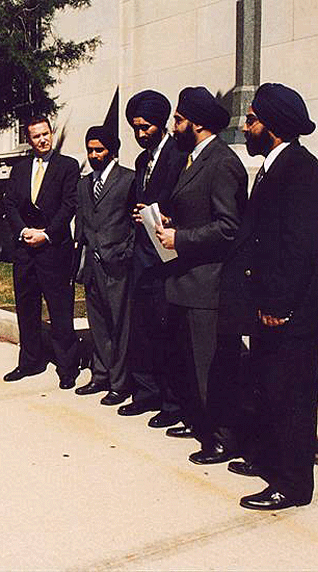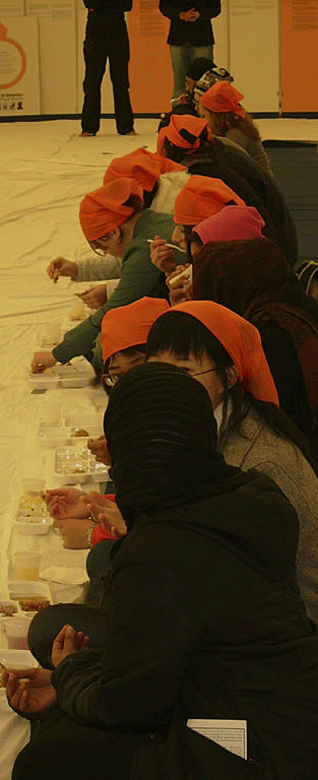
Sikh
Coalition
Above: The Sikh Coalition team speaks to the press. Below, third from bottom: A representative of SALDEF meets with police officers.

SALDEF


Columnists
Winning Friends
by I.J. SINGH
The young and the restless make a potent combination, not always wholesome or productive. What they often do is to remind me of a bull in a china shop.
But some young Sikhs today absolutely take my breath away - they are so nimble and sure-footed, and yet so focused and proactive.
I could list here the young founders of SALDEF (erstwhile SMART), The Sikh Coalition, United Sikhs, and many smaller Sikh groups. But they are already well known to Sikhs all over North America; their work is recognized by the highest echelons of Sikh and non-Sikh society. To them, we all owe a debt of gratitude for their unwavering commitment to defining the place of Sikhs and Sikhi as equal partners in this multiethnic, multicultural and multi-religious society.
I acknowledge today a small, almost minuscule, group of young Sikh students, numbering barely forty, at New York University ("NYU"). Mind you, at such a major academic institution as this in the middle of New York City, there are not many Sikhs on the faculty; I know of only two, and that's counting me. And I am at a campus that is some distance from the main facility that deals with the larger body of students, where most of these forty are to be found.
A week ago, a young undergraduate student at NYU, Nimeeta Kaur, called me. She heads the Association of Sikh Students - the merry band of forty - based there, and her group was planning a Sikh function. She had apparently come across some writings of mine, found them provocative, and wanted to invite me for a session of discussion with her group.
But not many of them knew me. So, I was first invited for a meeting with the officers of the club. That is a euphemistic way of putting it. I should say that for over an hour I was grilled and interviewed. I wouldn't be lying if I said that the probing was more rigorous than when I was hired by the university thirty-five years ago.
Did I mind such rigorous questioning by people a third of my age? Not at all; in fact, I rejoiced in the fact that their skills were so precisely honed. And I thought back to when I was their age; I must have been a bull in a china shop in comparison.
The topics they selected: death and dying; life after death; heaven, hell and points in between; and Sikh rites and practices associated with these. I looked at these young people living life at its edge, thriving in the liveliest corner of the world. I know that, at their age, thinking of end-of-life issues was never on my mind. Are they so far ahead of me, or was I so much slower? Their questions were precise, laced with citations from Guru Granth, and I was indeed not just impressed, but in awe.
And then they did something that I thought would be just a passing whim of theirs, but turned out to be a magical evening. Three days after the discussion, they scheduled a langar for the university community.
Nearly four hundred of their fellow students and some faculty showed up. These visitors learned the tradition of the langar (community meal), and the meaning behind it. They learned to sit on the floor and share a meal, while watching an excellent power-point presentation on Sikhi - its history, beliefs and practices. Dya Singh's melodious keertan played in the background; his music is a fusion of Punjabi and Western melodies and rhythms, and so much easier on the ears for such a mixed audience.
And then, the organizers made an opportunity for questions. Of course, after such a foodfest, the questions were soft and friendly, but not devoid of intelligent curiosity: Why do only men seem to wear turbans, while very few women do? Gender issues, lifestyle, food taboos, intoxicants, even the color of the turban engaged them.
Who prepared this langar? Nimeeta's parents cooked it and trucked it in. Who served it? The band of forty Sikhs, all barely out of their teens, of course!
This reminded me of two matters: First, that in our massive gurdwara that occupies over thirteen acres, we have never had an attendance approaching four hundred. The usual langar needs are satisfied with the cooking of ten pounds of rice. At NYU, forty pounds of rice were cooked, and the amount fell short at the end.
Secondly, we have never had more than five non-Sikhs in any gurdwara service on any given day, except perhaps at a marriage. And here were almost four hundred!
The room could comfortably accommodate about one hundred diners and, with a little imaginative modification, about one hundred and fifty were seated. At the first seating, one could clearly see the horde waiting outside the doors - just like at a rock concert, with "standing room only" signs and crowds of young people milling about outside.
The questions that the visitors asked may have been simple, but they fostered an exchange, engagement and understanding between Sikhs and non-Sikhs. Don't we often wonder how we can build bridges with our neighbours? At the end of the langar, many of the attendees filled out a short questionnaire about their experience.
Here was a model worth emulating.
Now think for a moment: Our gurdwaras, with minor exceptions that I may have missed, marginalize our young men and women; they have no voice in our programs, in defining what our institutions do, and where they are headed. Yet, we bemoan the fact that our neighbours know so little of us, and our young people are so dismissive of our gurdwara activities.
In this small group of young activists were males and females; among others, I take note of Nimeeta Kaur, Satjeet Kaur, Sandeep Singh, Mandeep Singh and Chanpreet Kaur. And theirs is an ongoing yearly event, not a once in a while "flash in the pan".
The initiative at New York University tells me that there can be no better way to make friends. First, I thought of Oscar Wilde, who reputedly remarked that, "To be in the best company, one has to feed people, amuse people or shock people".
Then, I saw that more apt to what was happening was Dale Carnegie's classic, How to Win Friends and Influence People.
I have often thought that the new edition of a book has to be better than the old, or it is no better than a reprint. Also, progress is possible only if, in time, the student excels the teacher, and the child excels the parent.
And I have often hoped that our young people would not only outdo us in the material and technological world in which we make a living, but also in the spiritual reality of Sikhi that would help them make a life.
Looking at the likes of these young Sikhs and their merry associates, I have no doubt that they will; in fact, they seem to be well on their way.
November 3, 2007
Conversation about this article
1: Jagpal Singh Tiwana (Dartmouth, Canada), November 03, 2007, 4:48 PM.
Thank you very much, Dr. I J Singh, for sharing the experience with us. The idea of holding a langar at the NYU campus is commendable, especially in these times when Sikhs are confused with Arabs. It would be quite interesting to know what the actual questions were that the students asked ... and what IJ's answers were.
2: Satinder Gill (Khanna, India), November 05, 2007, 10:30 AM.
I.J. Singh ji, I am absolutely bowled over by your writing and the topics you choose to write on. I lived in Canada for fourteen odd years before moving back to India since my husband had this intense desire to hold on to his roots. I loved my time in Canada and am dodging past the quirks and minor irritants that comprise of life in India but am taking it all with a pinch of salt and loving every minute of it. I am always amazed to see how the Sikh youth in western countries hold their Sikhism so close to their heart, uphold Sikh values and yet are so much a part of mainstream society. I do not see that kind of zeal here. Children are a lost lot and the emphasis is on all the wrong things. My four year old daughter goes to school here and I really do not know how to maintain a balance and help her find her way in life while staying in touch with her roots. One would think it is an easy task living in India. Trust me,it is not. My heart goes out to all those parents in western countries who have their children in boarding schools in India , especially in junior classes, in the fervent hope that they will stay connected to their culture. If we, as parents living here and our daughter coming home everyday, are facing this dilemma, I wonder how long-distance parents cope? This is how I feel and by giving voice to my feelings, I may have stirred a hornet's nest, but I do have a point. May Waheguru's blessings be with you all and, once again, my head bows in respect to your intelligent and thought-provoking pieces.
3: Tejwant (U.S.A.), November 05, 2007, 12:09 PM.
Isn't this what Sikhi is all about? Don't the doors of the Harmandar Sahib command us to open our own doors, both the tangible and the intangible ones? This is one more excellent introspection of the Sikhi way of life from I.J. Singh to all of us. Let's stop looking through our key holes to the outside world but open the doors with open arms. Just like the ones that lead us all to the Harmandar Sahib.
4: Roshan Kaur (Oakville, Ontario, Canada), November 06, 2007, 9:53 AM.
Considering that Sikhs constitute one of the most affluent minorities on this continent, as well as in other parts of the world, they should take on the task of serving and replenishing all food banks in their respective communities ... this is our mandate! Congratulations to the NYU students for their vision and commitment.
5: Satvir Kaur (Boston, U.S.A.), November 06, 2007, 11:59 AM.
A group of Sikhs in Boston was planning to do this last summer but somehow the plans didn't materialize; the problem being that except Boston University, not many local universities have a Sikh Students' Association. Maybe we will learn from our brothers and sisters at NYU and plan something for the coming months.
6: Manjyot Kaur (New York City, U.S.A.), November 06, 2007, 10:33 PM.
Kudos to NYU's "ambassadors of Sikhi"! It's great to know these kinds of events are happening. Let's hope these successful initiatives will be ongoing ones, and that they will not only benefit their school, but also help to spread positive and accurate information about Sikhs and Sikhi out to the community-at-large.
7: Harman Singh (Philadelphia, PA, U.S.A.), November 20, 2007, 9:48 PM.
I am a great fan of I.J Singh's essays. He constantly challenges me to reflect, re-evaluate and strengthen my beliefs. That is what the Gurus meant when they said: A Khalsa is one who constantly engages in "battle". The battle they are referring to is one of thought, of self-introspection. Is there a website where I could order all four of I.J. Singh's previously published essay books?


